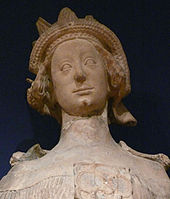Johanna von Pfirt
Johanna von Pfirt (Jeanne de Ferrette) (* 1300 in Basel ; † November 15, 1351 in Vienna ) was Countess von Pfirt and by marriage Duchess of Austria from the House of Habsburg .
Johanna was the eldest daughter of Count Ulrich III. (1281–1324) von Pfirt and his wife Princess Johanna von Mömpelgard (1284–1349), daughter of Count Reinald von Chalon-sur-Saône and granddaughter of Duke Hugos IV of Burgundy , born.
Marriage negotiations
With the death of the last Count von Pfirt, Ulrich III., In March 1324 in Basel, an important epoch began in the history of Alsace. The legacy he left to his two daughters, Johanna and Ursula, included the Sundgau , the southern Vosges , the Burgundy Gate and the northern edge of the Jura . Mindful of his advantage, Leopold I reacted to the news of Ulrich III's death. quickly. He sent his younger, still unmarried brother Albrecht to the widow, Johanna von Mömpelgard (Jeannette de Montbéliard) , so that he could ask for the hand of the eldest daughter Johanna. The widow compensated her youngest daughter Ursula (1315–1367) with an allowable sum for the waiver of inheritance. The negotiations were successful, and on March 17th she sealed the contract with Albrecht in Thann . He gave the Habsburgs the only compact political unit in Alsace .
Marriage and offspring

On March 26, 1324 the wedding between Countess Johanna von Pfirt and Duke Albrecht II of Habsburg (1298-1358), son of the Roman-German King Albrecht I and his wife Elisabeth of Carinthia, Gorizia and Tyrol , took place in Vienna . In 1330, Duke Albrecht had symptoms of paralysis in his arms and legs ( polyarthritis ). That was also a misfortune because, despite six years of marriage, Johanna had not yet become pregnant. In 1337, the duke went on a pilgrimage to the relics of the Rhenish saints in Cologne and Aachen . The miracle that heaven had asked for came true: at the end of 1339 the 39-year-old duchess gave birth to her first child, Rudolf.
- Rudolf IV (1339-1365)
- ⚭ 1353 Catherine of Luxembourg , daughter of King Charles IV.
- Katharina (* 1342 ; † January 10, 1381 ), Poor Clare at St. Klara Monastery in Vienna; buried in St. Stephan in Vienna
- Margarethe (1346-1366)
- ⚭ 1359 Count Meinhard III. from Gorizia and Tyrol
- ⚭ 1364 Margrave Johann Heinrich of Moravia
- Friedrich III. (1347–1362), Duke of Austria
- Albrecht III. (1348–1395), Duke of Austria
- ⚭ 1366 Elisabeth of Luxemburg , daughter of King Charles IV.
- ⚭ 1375 Beatrix of Nuremberg-Hohenzollern , daughter of the Nuremberg burgrave Friedrich V.
- Leopold III. (1351–1386, fallen), founder of the Leopoldine line of the House of Habsburg
- ⚭ 1365 Viridis Visconti , daughter of Bernabò Viscontis , lord of Milan
Another five children of the couple were either stillborn or died without a name shortly after birth. They were all buried in the Duke's Crypt in St. Stephen's Cathedral in Vienna .
Life

The Duchess Johanna was considered clever and prudent. Politically gifted and skilled, she made an excellent complement to her husband. Because traveling caused him difficulty and pain, he sent her on a diplomatic mission. In 1336 Johanna brokered the peace between the Habsburgs and Luxembourgers, which later brought the Habsburgs into possession of the regions as far as the Adriatic . On a Princely Congress (1347) in the Lower Austrian town of Seefeld , King Charles IV enfeoffed Duke Albrecht and his sons with Austria , Styria , Carinthia , Carniola and the Windische Mark . Since the lame and wise Duke Albrecht, despite all his love of peace, knew how to wage wars if it promised him advantages, he used the next opportunity to attack the Patriarchate of Aquileia ; his wife Johanna had arranged an alliance there in 1335 to provide her husband with the necessary backing for his Carinthian ambitions, but now that Carinthia, Krain and the Windische Mark had been acquired, Albrecht no longer needed his ally. He took Chiusa , San Michele , Venzone , Gemona and a few other places from the Patriarch .
When her last son was born, 51-year-old Johanna died and was buried in the crypt of the church of the Gaming Charterhouse , which her husband had founded in 1330.
literature
- Constantin von Wurzbach : Habsburg, Johanna Hereditary Countess von Pfyrt . In: Biographisches Lexikon des Kaiserthums Oesterreich . 6th part. Imperial-Royal Court and State Printing Office, Vienna 1860, p. 287 f. ( Digitized version ).
- Johanna von Pfirt. In: Brigitte Hamann (Ed.): The Habsburgs. A biographical lexicon. Piper, Munich / Zurich 1988, ISBN 3-492-03163-3 .
- Richard Reifenscheid: The Habsburgs. From Rudolf I to Karl I special edition. Tosa et al., Vienna 1994, ISBN 3-85001-484-3 .
Web links
Individual evidence
- ↑ Adolph von Wolfskron: The pictures of the Hedwig legend . Based on a manuscript from 1353 in the library of the PP Piarists in Schlackenwerth with an extract from the original text and historical-archaeological notes, Leipzig, Verlag Fleischer, 1846, column 50
- ^ Aquilin Julius Caesar : State and Church History of the Duchy of Steyermark . 1785-1788, Volume 5, p. 338
| personal data | |
|---|---|
| SURNAME | Johanna von Pfirt |
| ALTERNATIVE NAMES | Jeanne de Ferretes |
| BRIEF DESCRIPTION | Duchess of Austria from the House of Habsburg |
| DATE OF BIRTH | 1300 |
| PLACE OF BIRTH | Basel |
| DATE OF DEATH | November 15, 1351 |
| Place of death | Vienna |
